4
Squatting Chi Kung
A NATURAL POSTURE
One of the most wonderful Tan Tien Chi Kung exercises undoubtedly is squatting. It is a very common posture in many regions of the world that have been less affected by modernization. In these regions squatting is considered a relaxing posture, yet in the modern West it is now considered “exercise.”
Since the beginning of civilization, people have known the highly beneficial effects of squatting. Their bodies told them to do so and in this way they created a deep state of relaxation in which the sacrum and spine are open and the warm life current in the body maintains an optimal, free flow.
Squatting is also closely connected with togetherness. When people in traditional communities relax, they often squat together in a circle. It is also the ideal position for work in the fields, as work can be easily alternated with moments of rest. It is also part of the realm of play and playfulness among children.
As the squatting position generates a state of relaxation and stillness, it is also a natural posture for meditative practice. In many indigenous cultures, people assume the squatting position precisely for that reason.
It is not incidental that this yoga position (in the original meaning of the Sanskrit word yoga, which means “union”) is the one that comes closest to that of the child in its embryonic high-energy state. In the squatting posture, our capacity for energy storage is optimal, the metabolic rate is low, and energy consumption most economical.
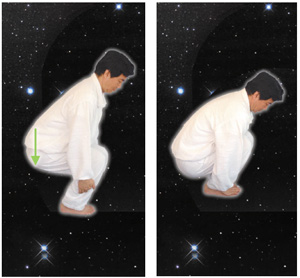
SQUATTING POSITION
The sleeping posture in which one lies on one’s side with the legs pulled in is similar to the squatting position. The subconscious counsels this position for its regenerating quality.
In many cultures, when people die they are laid in the squatting position because it resembles most closely that of the child before it was born. Thus body is thus laid to rest in a position that reconnects the body with its original state of being.
Squatting may perhaps be called Tan Tien Chi Kung exercise number one, but let’s protect its entirely natural character for those who are spontaneous Chi Kung practitioners without knowing it. Our body naturally knows the wisdom of this posture.
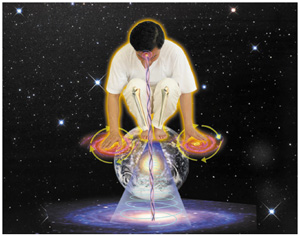
SQUATTING TO CONNECT WITH MOTHER EARTH AND THE GALAXY BELOW
SQUATTING AND THE PSOAS
More than any other posture, squatting opens the lower lumbar vertebrae and thereby prevents hernia. It also activates the latent motor force of the pelvis, opens the groin, flexes the hip joints, induces downward pressure and release of waste, gases, and toxins, and reactivates the colon. (Squatting has been the position humans historically have used to move the bowels.) By the gravity pull it provokes, it stirs the earth Chi current to move and bounce upward to the perineum, awakening the spinal fluids in the sacrum, and opening and elongating the spine. This action rebalances the vertebrae and eases the Chi current upward to the crown.
Additionally, the squatting posture massages the lungs and heart. The lower Tan Tien helps the heart by facilitating and activating the Chi and blood flow.
Of particular importance is the role of squatting in lengthening the psoas, the muscles in the groin area that rotate the hip joint and flex the spine. The psoas tend to shorten with age, and can also be affected by anxiety and oversensitivity to cold temperatures. Shortening of the psoas pulls the body out of alignment and interferes with the correct upward and downward flow of Chi.
Maintaining suppleness in the psoas muscles is so important that there are Tao Yin practices that focus particularly on this area. The psoas is called the “soul muscle” in Chinese. In order for the soul to develop and for its eventual transference upward through the crown, it needs a well-aligned, straight body, in line with earth and heaven.
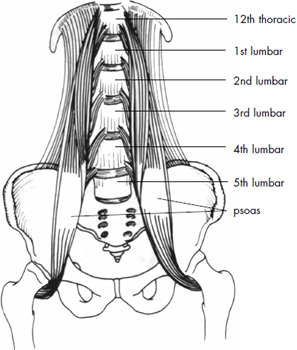
RELAXED PSOAS CONTRIBUTE TO OPTIMUM CHI FLOW
By relaxing the psoas, unity between the lower and the upper parts of the body is promoted. A flexible psoas makes it possible for the Chi to freely flow upward, connecting the lower lumbar with the lower part of the groin. When the psoas muscles are relaxed, the earth Chi can freely flow from the legs into the spine and upper body (via the perineum and sacrum).
Supple psoas muscles also facilitate free Chi flow between the kidneys and the heart. The free exchange between the fire Chi from the heart and the water Chi from the kidneys enables the kidneys to be warmed and the heart cooled. This is the basis of the balance between water and fire energy in the whole body, and thereby the balance between yin and yang.
SQUATTING PRACTICES
It is recommending that one practice squatting for three to five minutes each day to maintain good health and flexibility.
Squatting using a wall
- A good exercise for developing the squatting posture is to stand with your feet shoulder width apart, close to a wall (eighteen centimeters or more away from the wall), facing the wall. As you improve your squatting ability, you can move closer to the wall, and place the feet closer together.
- Place both hands on the sides, the tips of the fingers touching the sides of the thighs.
- Slowly drop straight down from the groin area, like you are sitting down. The wall will prevent you from leaning forward too much when you squat. Some people tend to lean the head and neck forward and the buttocks back. Using a wall will help you to see whether you are bending forward too much.
- Drop until you can’t go any further, and lightly bend the knees.
- Breathe into the lower Tan Tien. Keep the chest relaxed.
- As you squat down to the earth, feel a force pulling you down and a counterforce pulling you up.

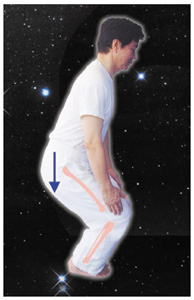
FACING A WALL, SQUAT STRAIGHT DOWN FROM THE GROIN
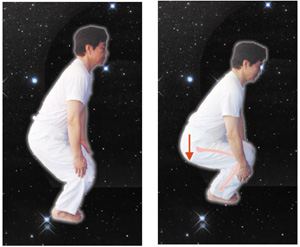
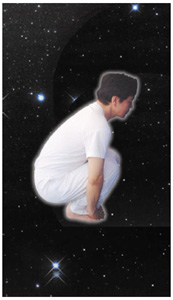
THE WALL WILL PREVENT YOU FROM BENDING FORWARD TOO MUCH
Squatting with a partner
- You can also practice squatting with the help of a partner or the edge of a table. When you work with a partner, stand facing each other, two to three feet apart. Place your feet shoulder-width apart.
- Stretch your arms toward your partner and firmly grasp one another’s wrists.
- From this position, squat straight down together from the groin while supporting one another.
- Sink as deep as you both can without leaning forward.
- Breathe into the lower Tan Tien. Keep the chest relaxed.
- As you squat down to the earth, feel a force pulling you down and a counterforce pulling you up.
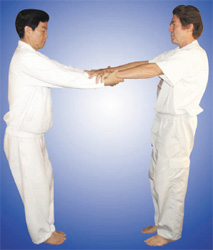

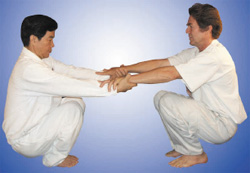
SQUAT WITH YOUR PARTNER, SUPPORTING ONE ANOTHER